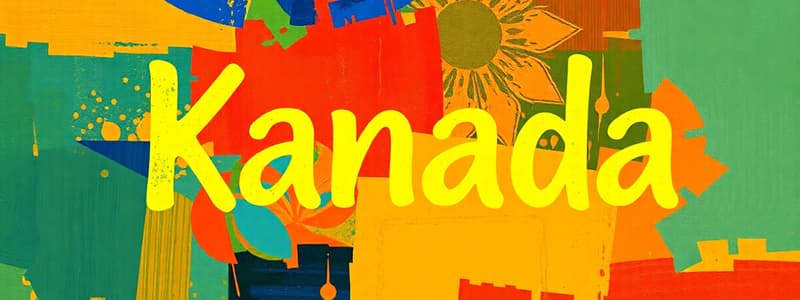Podcast
Questions and Answers
What is the primary characteristic of Kannada's script?
What is the primary characteristic of Kannada's script?
- It is alphabetic and consists of 26 letters.
- It is exclusively ideographic.
- It has no unique symbols and uses the Latin alphabet.
- It is syllabic and derived from the Brahmi script. (correct)
Which of the following is NOT a major dialect of Kannada?
Which of the following is NOT a major dialect of Kannada?
- Mysore Kannada (correct)
- Uttara Kannada
- Havigannada
- Surati
What is a distinctive feature of Kannada grammar?
What is a distinctive feature of Kannada grammar?
- It uses prefixing rather than suffixing.
- It lacks any inflectional morphology.
- It is highly agglutinative with suffixes indicating grammatical relations. (correct)
- It mainly relies on word order for grammatical relations.
Who is a notable figure associated with Modern Kannada literature?
Who is a notable figure associated with Modern Kannada literature?
How has the digital age affected Kannada language usage?
How has the digital age affected Kannada language usage?
Flashcards are hidden until you start studying
Study Notes
Overview of Kannada
- Kannada is a Dravidian language primarily spoken in the Indian state of Karnataka.
- It is one of the 22 scheduled languages of India and has official status in Karnataka.
Linguistic Characteristics
- Script: Kannada script, derived from the Brahmi script, is syllabic and has various phonetic symbols.
- Phonetics: The language has three vowels (a, e, i) with distinctions in short and long forms and 34 consonants.
- Grammar: Highly agglutinative; grammatical relations are indicated by suffixes.
Dialects
- Major dialects include:
- Havigannada: Spoken by agricultural communities.
- Uttara Kannada: Influenced by other regional languages.
- Surati: Spoken in urban areas.
Literature
- Rich literary heritage dating back to the 9th century.
- Notable periods:
- Old Kannada: 9th to 12th century; includes works like "Karnataka Sharanas."
- Modern Kannada: 19th century onwards; figures like Kuvempu and B. M. Srikantaiah.
- Kannada poetry, prose, and drama reflect diverse themes and styles.
Influence and Usage
- Spoken by over 50 million people; Kannada is used in education, administration, and media.
- The Karnataka Sahitya Akademi promotes the study and preservation of Kannada literature.
- Kannada cinema (Sandalwood) has contributed significantly to the language's popularity.
Cultural Significance
- Kannada is a key component of Karnataka's cultural identity.
- Festivals, music, and art forms deeply rooted in the language and literature.
Current Trends
- Growing digital presence with online courses, e-books, and social media usage.
- Increased interest in Kannada literature among younger generations.
Learning Resources
- Language courses, textbooks, and online platforms available for learners.
- Cultural immersion through films, music, and local communities enhances understanding of the language.
Overview
- Kannada is a Dravidian language spoken primarily in the Indian state of Karnataka.
- Kannada holds official status in Karnataka and is among India's 22 scheduled languages.
Linguistic Characteristics
- Kannada script, derived from the Brahmi script, is syllabic, utilizing various phonetic symbols.
- Kannada phonetics feature three vowels (a, e, i) with distinctions in shortened and lengthened forms.
- Kannada has 34 consonants.
- Kannada is a highly agglutinative language, using suffixes to convey grammatical relationships.
Dialects
- Major dialects of Kannada include:
- Havigannada, prevalent among agricultural communities.
- Uttara Kannada, exhibiting influences from neighboring languages.
- Surati, spoken in urban areas.
Literature
- Kannada possesses a rich literary tradition dating back to the 9th century.
- Key literary periods:
- Old Kannada (9th to 12th centuries), featuring works such as "Karnataka Sharanas."
- Modern Kannada (19th century onward), notable figures include Kuvempu and B.M. Srikantaiah.
- Kannada literature encompasses diverse themes and styles, including poetry, prose, and drama.
Influence and Usage
- Over 50 million people speak Kannada.
- Kannada serves as a medium in education, administration, and media.
- The Karnataka Sahitya Akademi champions the study and preservation of Kannada literature.
- Sandalwood, the Kannada film industry, has significantly contributed to the language's popularity.
Cultural Significance
- Kannada is integral to Karnataka's cultural identity.
- Festivals, music, and art forms are deeply intertwined with the language and literature.
Current Trends
- Kannada exhibits a growing digital presence, including online courses, e-books, and social media use.
- Kannada literature has seen a surge in interest among younger generations.
Learning Resources
- Language courses, textbooks, and online platforms are available for learners.
- Cultural immersion through films, music, and local communities enhances understanding of the language.
Studying That Suits You
Use AI to generate personalized quizzes and flashcards to suit your learning preferences.




